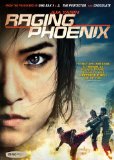Written by Diane Tillis
Raging Phoenix is a film of particular tastes and appeal. As someone who has very little experience with martial arts films, I may be the wrong person to comment on the quality of the fighting sequences or how it compares to other martial arts films. I will leave those comments to the people who are devoted fans and love these films. I can comment on the quality of the DVD so that those who are looking for a great addition to their martial arts film collection will know what to expect.
Raging Phoenix puts the quality of the fighting sequences ahead of the story. It was difficult for me to get through the first half of the film since there was very little in the way of dialog. For a moment, I thought I started the film in the middle! Forty-five minutes into the film, the story begins to take form. However, the story still takes a back seat to the fighting sequences.
This is the second feature film with up-and-coming Thai martial artist Yanin “Jeeja” Vismistananda. Fans will recognize her from Chocolate (2008) as the young autistic girl who learned martial arts by watching television. In Raging Phoenix, a mysterious Thai gang is kidnapping woman to use as organ donors or worse. Deu (played by Jeeja) was about to become another victim of this ruthless gang, but is saved by Sanim (Patrick Tang) who is working with a crew to stop these kidnaps. Deu learns a special form of martial arts called “Meyraiyuth” or drunken-fighting style. The style requires the artist to be intoxicated and to learn how to transform the energy of the alcohol into fighting power. As the crew formulates their plan of attack, the darker side of the kidnappings is revealed and victory seems impossible.
After a little research, I discovered the Meyraiyuth style is based on Muay Thai, and alcohol consumption is initially encouraged. In the film, the Meyraiyuth style is incorporated with other athletic practices such as break-dancing and free running. While these additions benefit some of the fighting sequences, they also can push them to be slightly comical. For instance in the first major fight sequence, the kidnappers are wearing jumping stilts with razors and jump around the scene like acrobats from Cirque du Soleil.
Video
The film is presented in the widescreen aspect ratio of 1.78:1. Colors are bright and intensified, especially on the beach scenes. The only high-black-level scenes are those that take place in the underground sequences. For the most part, minus the occasional flare light, the visuals are fine.
Audio
The audio is in available in Dolby Digital 5.1, in the original Thai language or dubbed English language, and with English and Spanish subtitles. I recommend turning off the surround sound system and listing to the film through the standard speakers of your television. This is because the surround system drowns out any sound effects from colliding bodies, grunts and moans of pain or bits of dialog with the soundtrack.
Special Features
Making of Raging Phoenix and Behind the Scenes of Raging Phoenix are both behind-the-camera featurettes on the film. I was kind of hoping for a feature on how the fight sequences are choreographed, but sadly there was none. These featurettes are composed of film clips and interviews.
Final Thoughts
As I stated, this film is not for me. During the first half, a friend and I survived the film by questioning the whereabouts of certain musical artists from our middle school years like Natalie Imbruglia. I can appreciate that some people may love this film while others may hate it. I stress this film is meant for someone who loves martial art films and can appreciate the complexity of the art form on the silver screen.




